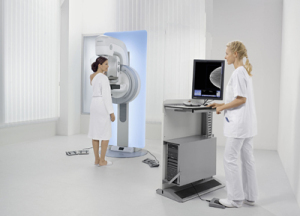by
Brendon Nafziger, DOTmed News Associate Editor | October 23, 2009

Siemens tomosynthesis technology
promises a lower recall rate
for breast cancer screening
A technique called tomosynthesis may be to mammograms what a CT scan is to an X-ray test in terms of specificity, according to Siemens Healthcare.
This week the equipment giant unveiled a 3D imaging program they're packing with their Mammomat Inspiration machines in Europe and Asia.
Currently, the cutting-edge technology, which might improve the accuracy of breast cancer diagnoses, is available at three clinical sites in Tokyo, Germany and Belgium.




Ad Statistics
Times Displayed: 44472
Times Visited: 1374 Keep biomedical devices ready to go, so care teams can be ready to care for patients. GE HealthCare’s ReadySee™ helps overcome frustrations due to lack of network and device visibility, manual troubleshooting, and downtime.
Unlike a traditional mammogram, which creates a series of two-dimensional X-rays of the breast -- compressed to visualize the anatomy -- tomosynthesis works by taking approximately 25 low-dose images throughout a 50-degree arc. The separate images are then rendered into a three-dimensional composite, much as they are with a CT scan -- in fact, tomosynthesis is actually known as "limited-angle CT."
One drawback of conventional mammograms is that the compression of the breast required to capture the images can force tissue to overlap, thereby hiding the dense, white areas (shadows) that indicate cancer.
As a result of this and other technical limitations, mammograms have high national recall rates. That is, women are called back by their doctors for additional testing in the 7 to 8 percent range, according to Regina Radtke, director of women's health for Siemens.
But Radtke tells DOTmed News that with tomosynthesis, early research suggests "typical average recall rates see a 30 percent reduction," although she's quick to stress that these are "very initial findings."
And even if it does outperform traditional mammography, there are still a number of obstacles to overcome.
Right now, it takes around half a minute to reconstruct the 3D image. While that might not sound like a lot of time, most women's health clinics are high-volume places because of the low rate of reimbursement per procedure, Radtke says, forcing centers to churn through 40 to 60 women daily.
On top of the comparatively slow speed of image reconstruction, there's also the time it takes for the interpreting radiologist to read the slides. "A typical breast radiologist spends...only 17-20 seconds looking at one case," she says, which is only a handful of images. But with tomosynthesis, "Depending on the size of the anatomy, we're giving 70 slides to look through," she says. "[There's a] learning curve. Radiologists will take longer to review."
Plus, the data demands of the procedure are huge for a hospital's IT infrastructure, Radtke says. A typical 2D mammogram takes around 80 to 100 megabytes, whereas tomosynthesis can take 2 to 4 gigabytes, according to Radtke, requiring a "substantial increase in storage space."
Not U.S. Approved
But the real question for the U.S. will be FDA approval, which could be some years down the road. Radtke says Siemens is only pushing for tomosynthesis to be an adjunct imaging system, used after conventional mammography suggests the need for further investigation, but before a patient is put through the risk and expense of a biopsy. Although tomosynthesis is promising as a first-line diagnostic modality, proving its eligibility for that use would require a large population study of women getting both X-ray exams and tomosynthesis, a doubling of radiation dose the FDA might not allow (the Siemens' machine gives radiation levels comparable to those received from traditional X-rays).
Nonetheless, Radtke says many countries, particularly in Scandinavia, are pushing for a more accurate replacement of conventional screenings. And with GE and Hologic researching their own tomosynthesis breast cancer systems, it may yet be the future of mammography.

